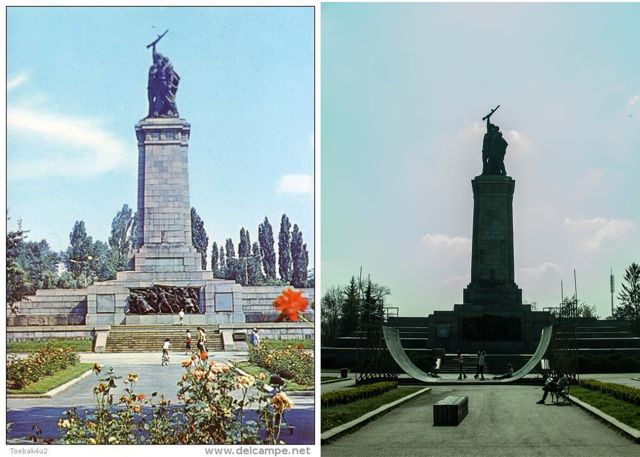Photos: Polina Spartyanova
Polina Spartyanova
The largest architectural and sculptural monument in Bulgaria stands in the centre of Sofia, near the National Assembly and Sofia University. It was built on an area of 2,000 square metres and was opened on 7 September 1954 on the occasion of the 10th anniversary of the invasion of the Soviet army in Bulgaria in order to "liberate it from fascism." The construction of the monument involved a creative team of many sculptors, painters and architects under the guidance of architect Danko Mitov.
 The solemn approach to the monument consists of two groups of sculptures that present moments of the cordial welcoming of the Soviet Army in Bulgaria in 1944. These groups of sculptures were made by a team headed by Professor Ivan Funev and are called "The Bulgarian people welcomes the Soviet Army of Liberation with bread and salt, flowers and gifts". The monument itself has the form of a high, truncated pyramid with a group of 8-metre-high sculptures standing on it, involving a Soviet warrior, Bulgarian worker and a mother with a child who together defeated fascism and went on the "bright road of socialism."
The solemn approach to the monument consists of two groups of sculptures that present moments of the cordial welcoming of the Soviet Army in Bulgaria in 1944. These groups of sculptures were made by a team headed by Professor Ivan Funev and are called "The Bulgarian people welcomes the Soviet Army of Liberation with bread and salt, flowers and gifts". The monument itself has the form of a high, truncated pyramid with a group of 8-metre-high sculptures standing on it, involving a Soviet warrior, Bulgarian worker and a mother with a child who together defeated fascism and went on the "bright road of socialism."
At the bottom of the monument, there are high relief compositions that tell the story of the establishment, strengthening and victorious march of the Soviet Army. The eastern high relief presents a composition called "October 1917" by Professor Dalchev. It depicts sailors, soldiers, workers, girls who, with revolutionary enthusiasm, formed the Soviet Army. The next high relief on the south side of the monument is a composition called "Everything for the front, everything for victory" by sculptor Peter Doychinov that depicts the Soviet people in the rear, putting all their efforts in support of their army.

The western high relief, "The Great Patriotic War of the Soviet Union" by sculptor Vassil Zahariev, shows the zeal for fight and the indomitable power of the Soviet Army in the war against the Nazi invaders. An inscription on the front side reads, "To the Soviet Army of Liberation from the grateful Bulgarian people". On both sides of the approach to the monument, there are 10 pedestals with bronze laurel wreaths symbolizing the ten most decisive attacks of the Soviet Army in the defeat over the German fascist army.
 After 1989, the Monument to the Soviet Army became the subject of fiery controversy in Bulgarian society regarding its meaning, purpose and future. Following a lengthy public debate, Sofia Municipal Council decided in 1993 to remove the monument but that did not happen, although there was a crane at the monument to remove the pieces from its top. In recent years, part of society has again proposed ideas for the demolition or removal of the monument because it embodies the totalitarian historiography regarding the Soviet army as a liberator and not as an occupier. Since 2011, the monument has become an attractive object of campaigns of political art, the majority of which express protest against the policy of the former Soviet Union and contemporary Russia. Just two months ago, one of the figures of the compositions was painted in the colours of the Ukrainian flag, accompanied by the words "Glory to Ukraine".
After 1989, the Monument to the Soviet Army became the subject of fiery controversy in Bulgarian society regarding its meaning, purpose and future. Following a lengthy public debate, Sofia Municipal Council decided in 1993 to remove the monument but that did not happen, although there was a crane at the monument to remove the pieces from its top. In recent years, part of society has again proposed ideas for the demolition or removal of the monument because it embodies the totalitarian historiography regarding the Soviet army as a liberator and not as an occupier. Since 2011, the monument has become an attractive object of campaigns of political art, the majority of which express protest against the policy of the former Soviet Union and contemporary Russia. Just two months ago, one of the figures of the compositions was painted in the colours of the Ukrainian flag, accompanied by the words "Glory to Ukraine".
Although the residents of Sofia have mixed feelings in terms of the Monument to the Soviet Army in Sofia, nowadays it is one of the most popular places, where young people gather. They go rollerskating and skateboarding there because of the smooth marble surface or just enjoy the nice view from the stairs of the monument. The elderly also gather there to celebrate communist holidays, although they are no longer part of the Bulgarian calendar.
